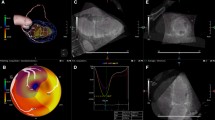Abstract
Purpose
Identification of viable myocardial tissue is important for patients with a low left ventricular ejection fraction, since revascularization is effective only if the affected region is viable. After cineangiographic identification of occluded coronary vessels, the myocardial viability is usually determined using cardiac MRI or SPECT. Alternatively, myocardial deformation imaging by echocardiography has been introduced that allows detection of viable myocardium directly within the catheterization laboratory. Multimodality fusion of coronary angiograms and echocardiograms was developed to match viable regions with areas affected by occluded vessels.
Methods
Identification of corresponding myocardial regions in both coronary angiograms and ultrasound scans was performed using multimodality image fusion. Geometrically correct superposition of these images was done to allow direct identification of the involved myocardial regions. An electromagnetic tracking system was used as a common base for co-registration of the images. The system was tested using a phantom test device in a cardiac catheterization laboratory.
Results
A 2D projection error of \(3.8 \pm 1.1\,\text {mm}\) was achieved in trials using a cardiac phantom test object.
Conclusions
Superimposition of the occluded coronary artery and the regional myocardial viability was achieved using automated multimodality fusion of coronary angiograms and stress echocardiograms with in vitro experiments. This system is promising for integrated single step angiography and angioplasty that may reduce procedure time, cost and length of hospitalization. Further testing in vivo is needed to verify and validate the system in a clinical setting.








Similar content being viewed by others
References
Bonow RO et al (2011) Myocardial viability and survival in ischemic left ventricular dysfunction. N Engl J Med 364(17):1617–1625
Pierard LA, De Landsheere CM, Berthe C, Rigo P, Kulbertus HE (1990) Identification of viable myocardium by echocardiography during dobutamine infusion in patients with myocardial infarction after thrombolytic therapy: comparison with positron emission tomography. J Am Coll Cardiol 15:1021–1031
Zaglavara T, Pilla T, Karvounis H, Haaverstad R, Parharidis G, Louridas G, Kenny A (2005) Detection of myocardial viability by dobutamine stress echocardiography: incremental value of diastolic wall thickness measurement. Heart 91:613–617
Rizzello V, Poldermans D, Schinkel AF, Biagini E, Boersma E, Elhendy A, Sozzi FB, Maat A, Crea F, Roelandt JR, Baxx JJ (2006) Long term prognosis value of myocardial viability and ischaemia during dobutamine stress echocardiography in patients with ischemic cardiomyopathy undergoing coronary revascularization. Heart 92:239–244
Anselmi M, Golia G, Cicoira M, Tinto M, Nitti MT, Trappolin R, Rossi A, Zanolla L, Marino P, Zardini P (1998) Prognostic value of detection of myocardial viability using low-dose dobutamine echocardiography in infarcted patients. Am J Cardiol 81:21–28
Varga A, Rodriguez MA, Picano E (2006) Safety of stress echocardiography. Am J Cardiol 98:541–543
Derumeaux G, Loufoua J, Pontier G, Cribier A, Ovize M (2001) Tissue Doppler imaging differentiates transmural from nontransmural acute myocardial infarction after reperfusion therapy. Circulation 103:589–596
Weidemann F, Dommke C, Bijnens B, Mertens P, Verbeken E, Maes A, Van de Werf F, De Scheerder I, Sutherland GR (2003) Defining the transmurality of a chronic myocardial infarction by ultrasonic strain-rate imaging. Circulation 107:883–888
Zhang Y, Chan AKY, Yu CM, Yip GWK, Fung JWH, Lam WWM, So NMC, Wang M, Wu EB, Wong JT, Sanderson JE (2005) Strain rate imaging differentiates transmural from non-transmural myocardial infarction. J Am Coll Cardiol 46:864–71
Atesok K, Schemitsch EH (2010 May) Computer-assisted trauma surgery. J Am Acad Orthop Surg 18(5):247–258
Aurora, Northern Digital Incorporated (2013) http://www.ndigital.com/products/aurora.php. Retrieved 3 May 2013
Tsai RY (1987) A versatile camera calibration technique for high-accuracy 3D machine vision metrology using off-the-shelf TV cameras and lenses. IEEE J Robot Autom 3(4):323–344
Wood B et al (2005) Navigation with electromagnetic tracking for interventional radiology procedures: a feasibility study. J Vasc Interv Radiol 16:493–505
Gutiérrez LF et al (2007) Multimodality image guidance system integrating X-ray fluoroscopy and ultrasound image streams with electromagnetic tracking. Proc SPIE 6509:65090K
Bisplinghoff S, de la Fuente M, Becker M, Radermacher K (2010) Registration method for displaying electromagnetically tracked devices in fluoroscopic images. In: Proceedings of the 32nd annual international conference of the IEEE engineering in medicine and biology society, pp 3719–3722
Hsu PW et al (2008) Comparison of freehand 3-D ultrasound calibration techniques using a stylus. Ultrasound Med Biol 34(10):1610–1621
Brendel B (2005) Intraoperativer Ultraschall zur Registrierung von Knochenstrukturen in der navigierten Chirurgie, PhD Thesis, Ruhr Universität Bochum, pp 65–98
Mountney P et al (2012) Ultrasound and fluoroscopic images fusion by autonomous ultrasound probe detection. MICCAI Lect Notes 7511:544–551
Elfring R (2012) Störungskompensation und Optimierung des elektromagnetischen Trackings in der computerunterstützten Chirurgie, PhD Thesis, RWTH Aachen University
Conflict of interest
Stefan Bisplinghoff, Christoph Hänisch, Michael Becker, Klaus Radermacher and Matias de la Fuente declare that they have no conflict of interest.
Informed consent
Informed consent was obtained from all patients for being included in the study.
Author information
Authors and Affiliations
Corresponding author
Rights and permissions
About this article
Cite this article
Bisplinghoff, S., Hänisch, C., Becker, M. et al. Fusion of coronary angiography and stress echocardiography for myocardial viability evaluation. Int J CARS 10, 11–17 (2015). https://doi.org/10.1007/s11548-014-1063-3
Received:
Accepted:
Published:
Issue Date:
DOI: https://doi.org/10.1007/s11548-014-1063-3




